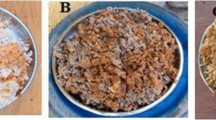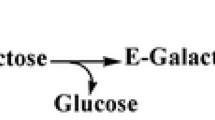Abstract
Different strains of Bifidobacteria, Lactobacilli and Pediococci spp. were evaluated for their utilization of xylo-oligosaccharides derived from Bengal gram husk and wheat bran water extractable polysaccharides. The fermentation pattern of xylo-oligosaccharides by bacteria depends on the nature of xylo-oligosaccharides i.e. degree of polymerization and arabinose to xylose ratio as well as the bacterial strain tested, which inturn are very important for designing species-specific prebiotic xylo-oligosaccharides and synbiotic preparations for incorporation in various health foods. All the bacterial strains tested readily utilized xylo-oligosaccharides derived from bengal gram husk and wheat bran as indicated by the increase in (a) turbidity of the culture broth (b) xylanase, xylosidase and arabinosidase activities (c) dry cell mass and (d) the liberation of short chain fatty acids (SCFA). Acetate was found to be the major SCFA produced as the end product of fermentation and its amount varied from 75.4 to 100 mol%. Xylo-oligosaccharides derived from wheat bran were found to have better prebiotic activity compared to the one derived from Bengal gram husk and this can be ascribed to relatively high amount of arabinose.
Similar content being viewed by others
References
Beldman G, Osuga D, Whitaker JR (1996) Some characteristics of β-D-xylopyranosidases, α-L-arabinofuranosidases and an arabinoxylan α-L-arabinofuranosidase from wheat bran and germinated wheat. J Cereal Sci 23:169–180
Berg RD (1996) The indigenous gastrointestinal microflora. Trends Microbiol 4:430–435
Berggren AM, Bjorck IEM, Nyman EMGL, Eggum BO (1993) Short-chain fatty acid content and pH in caecum of rats given various sources of carbohydrates. J Sci Food Agric 63:397–406
Bezkorovainy A, Miller-Catchpole R (1989) Nutrition and metabolism in Bifidobacteria. In: Biochemistry and physiology of bifidobacteria. CRC Press, Boca Raton, Florida, USA, pp 93–129
Borpuzari RN, Borpuzari T, Deuri B (2007) Probiotic characteristics of Lactobacillus acidophilus strains isolated from fermented milk. J Food Sci Technol 44:158–160
Chithra M, Muralikrishna G (2008) An improved method for obtaining xylanase from finger millet (Eleusine coracana var. ‘Indaf 15’) malt. J Food Sci Technol 45:166–169
Chithra M, Muralikrishna G (2010) Bioactive xylo-oligosaccharides from wheat bran soluble polysaccharides. LWT-Food Sci Technol 43:421–430
Crittenden R, Karppinen S, Ojanen S, Tenkanen M, Fagerstrom R, Matto J (2002) In vitro fermentation of cereal dietary fiber carbohydrates by probiotic and intestinal bacteria. J Sci Food Agric 82:781–789
Delzenne NM, Kok N (2001) Effects of fructans-type prebiotics on lipid metabolism. Am J Clin Nutr 73:456S–458S
Gibson GR (1999) Dietary modulation of the human gut micro flora using the prebiotics oligofructose and inulin. J Nutr 129:1438S–1441S
Gibson GR, Roberfroid B (1995) Dietary modulation of the human colonic microflora: introducing the concept of prebiotics. J Nutr 125:1401–1412
Gibson GR, Wang X (1994) Regulatory effects of Bifidobacteria on the growth of the colonic bacteria. J Appl Bacteriol 77:412–420
Gopal PK, Sullivan PA, Smart JB (2001) Utilization of galacto-oligosaccharides as selective substrates for growth by lactic acid bacteria including Bifidobacterium lactis DR 10 and Lactobacillus rhamnosus DR 20. Int Dairy J 11:19–25
Guarner F, Malagelada JR (2003) Gut flora in health and disease. Lancet 361:512–519
Holtl SM, Miller-Fosmore CM, Cote GL (2005) Growth of various intestinal bacteria on alternansucrase derived oligosaccharides. Lett Appl Microbiol 40:385–390
Hsu CK, Liao JW, Chung YC, Hsieh CP, Chan YC (2004) Xylo-oligosaccharides and fructooligosaccharides affect the intestinal microbiota and precancerous colonic lesion development in rats. J Nutr 134:1523–1528
Imaizumi K, Nakatsu Y, Sato M, Sedarnawati Y, Sugano M (1991) Effects of xylooligosaccharides on blood-glucose, serum and liver lipids and cecum short-chain fatty-acids in diabetic rats. Agric Biol Chem 55:199–205
Jaskari J, Kontula P, Siitonen A, Jousimies-Somer H, Mattila-Sandholm T, Poutanen K (1998) Oat β-glucan and xylan hydrolysates as selective substrates for Bifidobacterium and Lactobacillus strains. Appl Microbiol Biotechnol 49:175–181
Karppinen S, Liukkonen K, Aura AM, Forssell P, Poutanen K (2000) In vitro fermentation of polysaccharides of rye, wheat and oat brans and inulin by human faecal bacteria. J Sci Food Agric 80:1469–1476
Kleesen B, Sykura B, Zunft HJ, Blaut M (1997) Effects of inulin and lactose on faecal microflora, microbial activity and bowel habit in elderly constipated persons. Am J Clin Nutr 65:1397–1402
Kraehenbuhl JP, Corbett M (2004) Keeping the gut microflora at bay. Science 303:1624–1625
Laparra JM, Sanz Y (2010) Interactions of gut microbiota with functional food components and nutraceuticals. Pharmacol Res 61:219–225
Macfarlane S, Macfarlane GT (2003) Regulation of short-chain fatty acid production. Proc Nutr Soc 62:67–72
Madhukumar MS, Muralikrishna G (2010) Structural characterization and determination of prebiotic activity of purified xylo-oligosaccharides isolated from Bengal gram husk (Cicer arietinum) and wheat bran (Triticum aestivum). Food Chem 118:215–223
Mai V Jr, Morris JR (2004) Colonic bacterial flora: changing understandings in the molecular age. J Nutr 134:459–464
Miller GL (1959) Use of Dinitrosalicylic acid reagent for determination of reducing sugar. Anal Chem 31:426–428
Moura P, Cabanas S, Lourenco P, Girio F, Loureiro-Dias MC, Esteves MP (2008) In vitro fermentation of selected xylo-oligosaccharides by piglet intestinal microbiota. LWT-Food Sci Technol 41:1952–1961
Okazaki M, Fujikawa S, Matsumoto N (1990) Effect of xylooligosaccharide on the growth of bifidobacteria. Bifidobacteria Microflora 9:77–86
Perrin S, Warchol M, Grill JP, Schneider F (2001) Fermentations of fructo-oligosaccharides and their components by Bifidobacterium infantis ATCC 15697 on batch culture in semi-synthetic medium. J Appl Microbiol 90:859–865
Rao RSP, Muralikrishna G (2004) Non-starch polysaccharide-phenolic acid complexes from native and germinated cereals and millet. Food Chem 84:527–531
Rehman SU, Babu I, Zahoo T, Nawaz H, Bhatti IA, Latif F, Mumtaz S (2008) Extraction of xylooligosaccharides from hard-shell almond variety (‘Wirin’) and their utilization in cookies. J Food Sci Technol 45:527–530
Ruppin H, Bar-Meir S, Soergel KH, Wood CM, Schmitt MG (1980) Absorption of short chain fatty acids by the colon. Gastroenterology 78:1500–1507
Sawardekar JS, Slonekar JM, Jeanes A (1965) Quantitative determination of monosaccharides as their alditol acetates by gas chromatography. Anal Chem 37:1602–1604
Silvi S, Rumney CJ, Cresci A, Rowland IR (1999) Resistant starch modifies gut micro flora & microbial metabolism in human flora associated rats inoculated with faeces from Italian and UK donors. J Appl Microbiol 86:521–530
Smiricky-Tjardes MR, Flickinger EA, Grieshop CM, Bauer LL, Murphy MR, Fahey GC (2003) In vitro fermentation characteristics of selected oligosaccharides by swine fecal microflora. J Anim Sci 81:2505–2514
Swennen K, Courtin CM, Delcour JA (2006) Non-digestible oligosaccharides with prebiotic properties. Crit Rev Food Sci Nutr 46:459–471
Whistler RL, Durso DF (1950) Chromatographic separation of sugars on charcoal. J Am Chem Soc 72:677–679
Acknowledgment
We thank Dr. V. Prakash, F.R.Sc, Director, C.F.T.R.I., Mysore, for his keen interest in the work, and encouragement. The authors also thank Dr. M. C. Varadaraj, H.O.D, Human Resource Department, C.F.T.R.I. Mysore, for providing the facilities for prebiotic experiments. M.S.M. thanks the Council of Scientific and Industrial Research (C.S.I.R.), New Delhi, India for the grant of senior research fellowship.
Author information
Authors and Affiliations
Corresponding author
Rights and permissions
About this article
Cite this article
Madhukumar, M.S., Muralikrishna, G. Fermentation of xylo-oligosaccharides obtained from wheat bran and Bengal gram husk by lactic acid bacteria and bifidobacteria. J Food Sci Technol 49, 745–752 (2012). https://doi.org/10.1007/s13197-010-0226-7
Revised:
Accepted:
Published:
Issue Date:
DOI: https://doi.org/10.1007/s13197-010-0226-7




